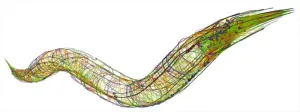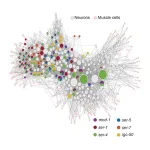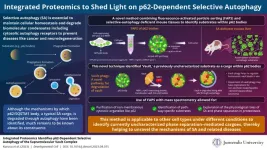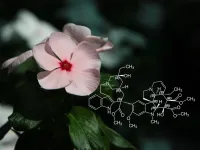(Press-News.org) Because serotonin is one of the primary chemicals the brain uses to influence mood and behavior, it is also the most common target of psychiatric drugs. To improve those drugs and to invent better ones, scientists need to know much more about how the molecule affects brain cells and circuits both in health and amid disease. In a new study, researchers at The Picower Institute for Learning and Memory at MIT working in a simple animal model present a comprehensive accounting of how serotonin affects behavior from the scale of individual molecules all the way to the animal’s whole brain.
“There have been major challenges in rationally developing psychiatric drugs that target the serotonergic system,” said Steve Flavell, associate professor in The Picower Institute and MIT’s Department of Brain and Cognitive Sciences, and senior author of the study in Cell. “The system is wildly complex. There are many different types of serotonergic neurons with widespread projections throughout the brain and serotonin acts through many different receptors, which are often activated in concert to change the way that neural circuits work.”
These same complexities that scientists face in people are all afoot in the nematode worm C. elegans, but to a more manageably limited degree. C. elegans has only 302 neurons (rather than billions) and only six serotonin receptors (rather than the 14 found in people). Moreover, all C. elegans neurons and their connections have been mapped out and its cells are accessible for genetic manipulation. Finally, Flavell’s team has developed imaging technologies that enable them to track and map neural activity across the worm’s brain simultaneously. For all these reasons, the lab was able to produce a novel study revealing how the far-reaching molecular activity of serotonin changes brain-wide activity and behavior.
“These results provide a global view of how serotonin acts on a diverse set of receptors distributed across a connectome to modulate brain-wide activity and behavior,” the research team wrote in Cell.
The study’s co-lead authors are Picower Institute postdoc Ugur Dag, MIT Brain and Cognitive Sciences graduate student Di Kang, and former research technician Ijeoma Nwabudike, who is now a MD-PhD student at Yale.
Slowing for savoring
Flavell showed in Cell in 2013 that C. elegans uses serotonin to slow down when it reaches a patch of food and traced its source to a neuron called NSM. In the new study, the team used their many new capabilities developed since then at MIT to examine serotonin’s effects comprehensively.
First, they focused on identifying the functional roles of the worm’s six serotonin receptors. To do that they created 64 different mutant strains covering the different combinations of knocking out the various receptors. For instance, one strain would have just one receptor knocked out while another strain would have all but that one missing and another would be missing three. In each of these worms the team stimulated serotonin release from the NSM neuron to prompt slowing behaviors. Analysis of all the resulting data revealed at least two key findings: One was that three receptors primarily drove the slowing behavior. The second was that the other three receptors “interacted” with the receptors that drive slowing and modulated how they function. These complex interactions between serotonin receptors in the control of behavior is likely to be directly relevant to psychiatric drugs that target these receptors, Flavell said.
The researchers also gained other important insights into serotonin’s actions. One was that different receptors respond to different patterns of serotonin release in live animals. For example, the SER-4 receptor only responded to sudden increases in serotonin release by the NSM neuron. But, the MOD-1 receptor responded to continuous “tonic” changes in serotonin release by NSM. This suggests that different serotonin receptors are engaged at different times in the live animal.
Brain-wide mapping
Having teased out the roles of the serotonin receptors in the control of C. elegans behavior, the research team then used their imaging technologies to see how serotonin’s effects worked at a circuit level. For instance, they fluorescently tagged each receptor gene in each neuron across the brain so that they could see all the specific cells that expressed each receptor, providing a brain-wide map of where the serotonin receptors are located in C. elegans. About half of the worm’s neurons express serotonin receptors with some neurons expressing as many as five different types.
Finally, the team used their ability to track all neuron activity (based on their calcium fluctuations) and all behaviors to watch how the serotonergic neuron NSM affected other cells’ activity as worms freely explored their surroundings. About half of the neurons across the worm’s brain changed activity when serotonin was released. Since they knew which exact neurons they were recording from, the research team asked whether knowing which serotonin receptors each cell expressed could predict how they responded to serotonin. Indeed, knowing which receptors were expressed in each neuron and its input neurons gave strong predictive power of how each neuron was impacted by serotonin.
“We performed brain-wide calcium imaging in freely-moving animals with knowledge of cellular identity during serotonin release, providing, for the first time, a view of how serotonin release is associated with changes in activity across the defined cell types of an animal’s brain,” the researchers concluded.
All these findings shed light on the kinds of complexities and opportunities facing drug developers, Flavell noted. The study’s findings show how the effects of targeting one serotonin receptor could depend on how other receptors or the cell types that express them are functioning. In particular, the study highlights how the serotonin receptors act in concert to change the activity states of neural circuits.
In addition to Flavell, Dag, Nwabudike and Kang, the paper’s other authors are Matthew Gomes, Jungsoo Kim, Adam Atanas, Eric Bueno, Cassi Estrem, Sarah Pugliese, Ziyu Wang and Emma Towlson.
Study funders included the National Institutes of Health, the National Science Foundation, the McKnight Foundation, the Alfred P. Sloan Foundation, the Picower Institute and the JPB Foundation.
END
From molecular to whole-brain scale in a simple animal, study reveals serotonin’s effects
2023-05-15
ELSE PRESS RELEASES FROM THIS DATE:
Assessment of sociodemographics and inflation-related stress
2023-05-15
About The Study: This analysis of U.S. Census Bureau survey data found that rising inflation has become a significant source of stress, especially among women and those who were socioeconomically more vulnerable.
Authors: Cary Wu, Ph.D., of York University in Toronto, is the corresponding author.
To access the embargoed study: Visit our For The Media website at this link https://media.jamanetwork.com/
(doi:10.1001/jamanetworkopen.2023.13431)
Editor’s Note: Please see the article for additional information, including other authors, author contributions and affiliations, ...
Population-based estimates for the prevalence of multiple sclerosis in the US
2023-05-15
About The Study: In this national population-based cohort study of multiple sclerosis (MS) prevalence, researchers found that the distribution of MS in the United States has become more racially and ethnically diverse. White individuals continued to have the highest prevalence of MS followed by Black individuals, individuals from other races, and Hispanic individuals.
Authors: Mitchell T. Wallin, M.D., M.P.H., of the University of Maryland School of Medicine in Washington, D.C., is the corresponding author.
To access the embargoed study: Visit our For The Media website at this link https://media.jamanetwork.com/
(doi:10.1001/jamaneurol.2023.1135)
Editor’s ...
Risk of Parkinson disease among service members at Marine Corps Base Camp Lejeune
2023-05-15
About The Study: This study of 340,000 service members found that the risk of Parkinson disease was 70% higher in veterans who were stationed at Marine Corps Base Camp Lejeune, North Carolina, during 1975-1985 when the water supply was contaminated with the solvent trichloroethylene and other volatile organic compounds. The findings suggest that exposure to trichloroethylene in water may increase the risk of Parkinson disease; millions worldwide have been and continue to be exposed to this ubiquitous environmental contaminant.
Authors: Samuel M. Goldman, ...
New study using novel approach for glioblastoma treatment shows promising results, extending survival
2023-05-15
TORONTO - A new international study published in Nature Medicine and presented as a late-breaking abstract at the American Association of Neurological Surgeons (AANS) annual conference, shows great promise for patients with glioblastoma.
Drs. Farshad Nassiri and Gelareh Zadeh, neurosurgeons at the University Health Network (UHN) in Toronto, published the results of a Phase 1/2 clinical trial investigating the safety and effectiveness of a novel therapy which combines the injection of an oncolytic virus – a virus that targets and kills ...
Finding ‘vault’: Unravelling the mysteries of p62-bodies and the cellular recycling pathway
2023-05-15
Our body functioning is delicately balanced between the synthesis and breakdown of various cellular components. When these cellular components grow old or get damaged, they are digested by a process called “autophagy”—literally, “self-eating.” This process not only helps in the elimination of toxic wastes, but also helps to deliver building blocks for the synthesis of new cellular macromolecules. Thus, autophagy serves as the body's cellular cleaning and recycling system.
Researchers have long been studying the ...
Comprehensive analysis of single plant cells provides new insights into natural product biosynthesis
2023-05-15
Plants are impressive in their diversity, but especially in the variety of metabolites they produce. Many plant natural products are highly complex molecules, such as the alkaloids vincristine and vinblastine, which are produced by the Madagascar periwinkle Catharanthus roseus. These two substances are already indispensable in cancer therapy.
Researchers are very interested in finding out which individual biosynthetic steps are required to form the complex molecules. "Currently, these compounds are still obtained in very small quantities from the plant's leaf extract. We can learn from the plant how this compound is produced and use this knowledge ...
Dementia study reveals how toxic proteins spread through brain
2023-05-15
Fresh insights into the spread of damaging proteins that build up in the brains of people with Alzheimer’s disease could hold the key to stopping the condition progressing, a study says.
Researchers have discovered that synapses, which send essential signals through the brain, are also transporting toxic proteins known as tau around the brain.
Large clumps of the protein tau – called tangles – form in brain cells and are one of the defining features of Alzheimer’s disease. As these tangles spread through the brain during the disease there is a decline in ...
Combined delivery of engineered virus with immunotherapy is safe and improves outcomes in subset of patients with glioblastoma
2023-05-15
HOUSTON ― Intratumoral delivery of an engineered oncolytic virus (DNX-2401) targeting glioblastoma (GBM) cells combined with subsequent immunotherapy was safe and improved survival outcomes in a subset of patients with recurrent GBM, according to results from a multi-institutional Phase I/II clinical trial co-led by researchers at The University of Texas MD Anderson Cancer Center and the University of Toronto.
The study, published today in Nature Medicine, met its primary safety endpoint and demonstrated the combination was well tolerated overall with no dose-limiting toxicities. The study did not meet its primary efficacy endpoint of objective response rate, but ...
Mass General Brigham investigators identify new genetic variant protective against Alzheimer's disease
2023-05-15
A single patient can spark new research questions and provide answers about a disease. And when a new case is identified, investigators can make connections between them that can lead to even more powerful and persuasive ideas about cause and treatment. In a publication today in Nature Medicine, an international team led by investigators from two Mass General Brigham hospitals — Massachusetts General Hospital (MGH) and Mass Eye and Ear — reports on a new case of a patient with a genetic predisposition for developing early-onset Alzheimer’s disease who remained cognitively intact until his late 60s. Through clinical assessments ...
Out of this world control on Ice Age cycles
2023-05-15
A research team, composed of climatologists and an astronomer, have used an improved computer model to reproduce the cycle of ice ages (glacial periods) 1.6 to 1.2 million years ago. The results show that the glacial cycle was driven primarily by astronomical forces in quite a different way than it works in the modern age. These results will help us to better understand the past, present, and future of ice sheets and the Earth’s climate.
Earth’s orbit around the Sun and its spin axis orientation change slowly over time, due to the pull of gravity from the Sun, the Moon, and other planets. These astronomical forces affect the environment on Earth due to changes in ...






